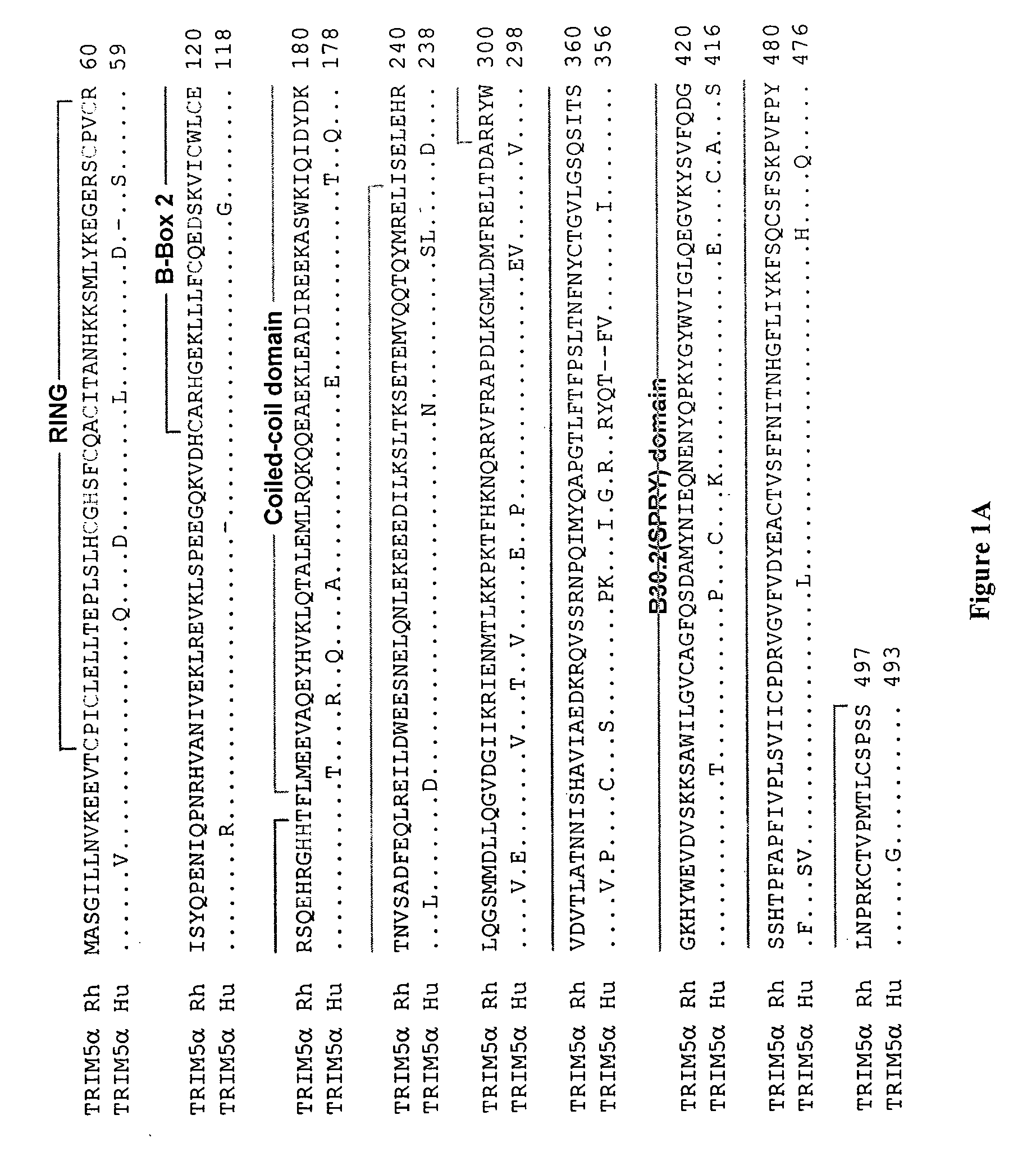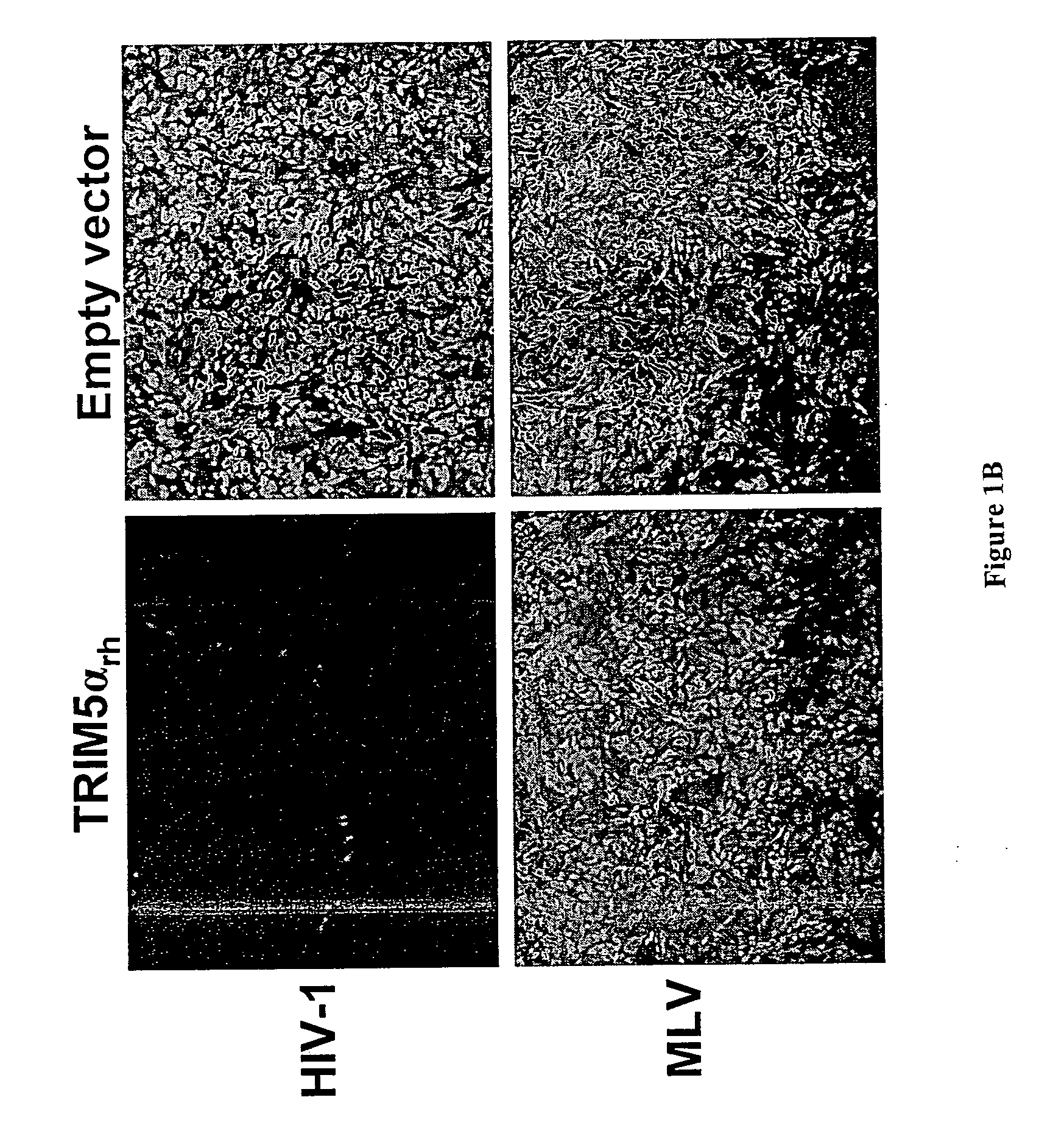Methods and compositions for the treatment and prevention of HIV infection using TRIM5alpha
a technology of hiv infection and composition, applied in the field of methods and compositions for the treatment and prevention of hiv infection using trim5alpha, can solve the problems of major global health problems such as aids
- Summary
- Abstract
- Description
- Claims
- Application Information
AI Technical Summary
Benefits of technology
Problems solved by technology
Method used
Image
Examples
example 1
A. Materials and Methods
Screen for HIV-1-Resistant Cells.
[0320] A primary rhesus lung (PRL)4 cDNA library (3.2×106 independent clones) was inserted into the pLIB vector (Clontech) and used to transduce 3×106 HeLa cells. Three days later, a total of 6×106 transduced cells were reseeded in batches of 5×105 cells in 10-cm dishes and incubated with sufficient HIV-1.GFP to infect at least 99% of the cells. Approximately 0.5% of the cells were selected for the absence of fluorescence using a FACS Vantage SE cell sorter (Becton Dickinson). Collected cells were allowed to grow into 500-cell colonies and subjected to a second round of HIV-1.GFP infection at a high multiplicity of infection. GFP-negative colonies were identified by fluorescence microscopy, cloned and expanded. A total of 313 HeLa clones from seven sequential screens were selected and tested for susceptibility to HIV-1.GFP and SIV.GFP. Two clones with a selective block to HIV-1.GFP were identified. Eleven cDNA inserts from...
example 2
Identification of Polymorphisms in TRIM5α
[0337] Starting with 0.05 μg of human DNA (i.e., from blood samples) from long term non-progressors (i.e., individuals who have been infected with HIV for 7-12 years and yet retain a CD4+ cell count within the normal range) the eight exons of TRIM5αhu (including the 5′- and 3′UTRs (SEQ ID NOs.:67, 68, 69, 70, 71, 72, 73, and 74) are amplified in separate reactions by PCR using primers with sequences for M13F or M13R Universal primers at 5′ ends. The amplified fragments are purified and sequenced with the M13R and F primers to obtain the entire sequence of each exon. The amplified sequences are then compared to the normal cDNA sequence (SEQ ID NO.:47) to identify sequence variants.
example 3
Species-Specific Variation in the B30.2 (SPRY) Domain of TRIM5α Determines the Potency of Human Immunodeficiency Virus (HIV) Restriction
A. Materials and Methods
TRIM5α Chimerae.
[0338] The TRIM5 cDNA from humans and rhesus monkeys were obtained from a kidney cDNA library (Clontech) and from a primary rhesus lung cDNA library, respectively (Stremlau, M., et al. (2004) Nature 427:848-8539). The nomenclature for the chimerae is TRIM5α A(Bx-y), in which the encoded TRIM5α amino acids from x to y from species B are inserted into the TRIM5α protein of species A (H=human; R=rhesus monkey). The numbering scheme is based on the human TRIM5α residue numbers; the same numbers are used for the rhesus monkey TRIM5α residues, after the TRIM5αrh sequence is aligned to that of TRIM5αhu.
[0339] Some of the chimeric TRIM5 constructs were created by exchanging fragments generated by digestion with the restriction enzymes Bsml I (TRIM5α R(H286-493) and TRIM5α H(R286-493)) or Bsml I and BamH I (TRIM5...
PUM
| Property | Measurement | Unit |
|---|---|---|
| pH | aaaaa | aaaaa |
| Tm | aaaaa | aaaaa |
| gap length | aaaaa | aaaaa |
Abstract
Description
Claims
Application Information
 Login to View More
Login to View More - R&D
- Intellectual Property
- Life Sciences
- Materials
- Tech Scout
- Unparalleled Data Quality
- Higher Quality Content
- 60% Fewer Hallucinations
Browse by: Latest US Patents, China's latest patents, Technical Efficacy Thesaurus, Application Domain, Technology Topic, Popular Technical Reports.
© 2025 PatSnap. All rights reserved.Legal|Privacy policy|Modern Slavery Act Transparency Statement|Sitemap|About US| Contact US: help@patsnap.com



